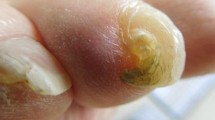Abstract
Retronychia is a condition, first described in 1999, characterized by the embedding of the proximal nail plate into the proximal nail fold and the stacking of a multiple generations of nail plates beneath the proximal nail fold. The disease affects frequently the toenails and is associated with stress-relevant situations including repetitive trauma, ischemic etiologies, postpartum, and compartment syndrome. Predisposing factors including static disorder of the feet may be underestimated. The paucity of data regarding the predisposing factors is because existing studies are limited to small case reports, case series, and retrospective studies. The diagnosis is clinical, which could be challenging because retronychia can easily mimic other nail disorders with chronic paronychia. Since the first description, significant advances have been made regarding diagnostic criteria including ultrasonography. We performed a systematic review of the literature on retronychia from inception to April 2018 with an emphasis on the pathogenesis and new diagnostic and management trends.




Similar content being viewed by others
References
de Berker DA, Rendall JR (1999) Retronychia—proximal ingrowing nail. J Eur Acad Dermatol Venereol 12(suppl 2):S126
Braswell MA, Daniel CR 3rd, Brodell RT (2015) Beau lines, onychomadesis, and retronychia: a unifying hypothesis. J Am Acad Dermatol 73(5):849–855
de Berker DA, Richert B, Duhard E, Piraccini BM, André J, Baran R (2008) Retronychia: proximal ingrowing of the nail plate. J Am Acad Dermatol 58(6):978–983
Dahdah MJ, Kibbi AG, Ghosn S (2008) Retronychia: report of two cases. J Am Acad Dermatol 58(6):1051–1053
Ventura F, Correia O, Duarte AF, Barros AM, Haneke E (2016) Retronychia–clinical and pathophysiological aspects. J Eur Acad Dermatol Venereol 30(1):16–19
Baumgartner M, Haneke E (2010) Retronychia: diagnosis and treatment. Dermatol Surg 36(10):1610–1614
Gerard E, Prevezas C, Doutre MS, Beylot-Barry M, Cogrel O (2016) Risk factors, clinical variants and therapeutic outcome of retronychia: a retrospective study of 18 patients. Eur J Dermatol 26(4):377–381
Piraccini BM, Richert B, de Berker DA, Tengattini V, Sgubbi P, Patrizi A, Stinchi C, Savoia F (2014) Retronychia in children, adolescents, and young adults: a case series. J Am Acad Dermatol 70(2):388–390
Retronychias Fouilloux B (2014) Presse Med 43(11):1223–1229
Alonso-Pacheco ML, de Miguel-Mendieta E, Maseda-Pedrero R, Mayor-Arenal M (2016) Retronychia: a case report including ultrasound imaging and surgical treatment. Actas Dermosifiliogr 107(5):e33–e37
Pizarro M, Pieressa N, Wortsman X (2017) Posttraumatic retronychia of the foot with clinical and ultrasound correlation. J Am Podiatr Med Assoc 107(3):253–256
Nakouri I, Litaiem N, Jones M, Zeglaoui F (2018) Retronychia clinical features and surgical treatment. J Am Podiatr Med Assoc 108(1):74–76
Wagner G, Sachse MM (2012) Congenital malalignment of the big toe nail. J Dtsch Dermatol Ges 10(5):326–330
Baran R, Bureau H, Sayag J (1979) Congenital malalignment of the big toe nail. Clin Exp Dermatol 4:359–360
Özdemir E, Bostanci S, Akyol A, Ekmekci P, Gürgey E (2005) Congenital malalignment of the great toenails in a pair of monozygotic twins. J Am Podiatr Med Assoc 95:398–400
Chaniotakis I, Bonitsis N, Stergiopoulou C, Kiorpelidou D, Bassukas ID (2007) Dizygotic twins with congenital malalignment of the great toenails: reappraisal of the pathogenesis. J Am Acad Dermatol 57(4):711–715
Haneke E (1999) Angeborener Schiefstand der Großzehennägel. In: Traupe H, Hamm H (eds) Pädiatrische Dermatologie. Springer, Berlin, pp 783–785
Wortsman X, Wortsman J, Guerrero R, Soto R, Baran R (2010) Anatomical changes in retronychia and onychomadesis detected using ultrasound. Dermatol Surg 36(10):1615–1620. https://doi.org/10.1111/j.1524-4725.2010.01694.x
Wortsman X, Calderon P, Baran R (2012) Finger retronychias detected early by 3D ultrasound examination. J Eur Acad Dermatol Venereol 26(2):254–256. https://doi.org/10.1111/j.1468-3083.2011.04068.x
Poveda-Montoyo I, Vergara-de Caso E, Romero-Pérez D, Betlloch-Mas I (2018) Retronychia a little-known cause of paronychia: a report of two cases in adolescent patients. Pediatr Dermatol 35(3):e144–e146
Campos MA, Santos A (2017) Retronychia: clinical diagnosis and surgical treatment. BMJ Case Rep. https://doi.org/10.1136/bcr-2016-218758
Cogrel O, Thomas L (2017) Chirurgie unguéale. In: Amici JM, Bailly JY, Beylot-Barry M, Egasse D, Thomas L (eds) Chirurgie dermatologique, 2nd edn. Elsevier Masson SAS, pp 275–300
Chiheb S, Richert B, Belyamani S, Benchikhi H (2010) Ingrown nail: a new cause of chronic perionyxis. Ann Dermatol Venereol 137(10):645–647
Zaraa I, Kort R, Mokni M, Ben Osman A (2012) Retronychia: a rare cause of chronic paronychia. Dermatol Online J 18(6):9
Ustuner P, Gulec AT (2012) Retronychia in a renal transplant recipient. Asian J Dermatol 4(1):6–10
Reigneau M, Pouaha J, Truchetet F (2013) Retronychia: four new cases. Eur J Dermatol 23(6):882–884
Kim M, Kang JH, Cho BK, Song CH, Ock SM, Park HJ (2015) Great toenail dystrophy: a single-center experience and review of the literature. Korean J Fam Med 36(2):113–120
Cabete J, Lencastre A (2015) Recognizing and treating retronychia. Int J Dermatol 54(1):e51–e52
Gatica-Torres M, Domínguez-Cherit J (2015) Retronychia treated with proximal nail avulsion; two cases successfully page 2 of 3 treated with this technique and the first cases of retronychia occurring after chemical matricectomy. Clin Res Dermatol Open Access 2(3):1–3
Fernández J, Reyes-Baraona F, Wortsman X (2017) Ultrasonographic criteria for diagnosing unilateral and bilateral retronychia. J Ultrasound Med 37(5):1201–1209
Robledo A, Godoy E, Manrique E, Manchado P (2017) Retronychia: an underdiagnosed disease. Dermatol Online J 23(7):15
Yale K, Jefferson J, Kirkorian AY (2017) A 15-year-old girl with a funky-looking great toenail. Pediatr Dermatol 34(6):717–718
Martin KL (2016) Disorders of the nails. In: Kliegman R, Stanton B, St Geme JW, Schor NF, Behrman RE (eds) Nelson textbook of pediatrics. Elsevier, pp 3197–3201
Funding
None.
Author information
Authors and Affiliations
Corresponding author
Ethics declarations
Conflict of interest
The authors declare that they have no conflict of interest.
Additional information
Publisher's Note
Springer Nature remains neutral with regard to jurisdictional claims in published maps and institutional affiliations.
Both Dr Noureddine Litaiem and Dr Haifa Drissi are first authors of the manuscript.
Rights and permissions
About this article
Cite this article
Litaiem, N., Drissi, H., Zeglaoui, F. et al. Retronychia of the toenails: a review with emphasis on pathogenesis, new diagnostic and management trends. Arch Dermatol Res 311, 505–512 (2019). https://doi.org/10.1007/s00403-019-01925-w
Received:
Revised:
Accepted:
Published:
Issue Date:
DOI: https://doi.org/10.1007/s00403-019-01925-w




